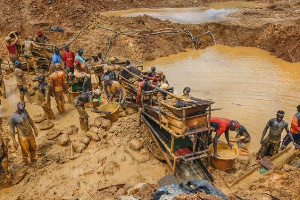Business Features of Thursday, 11 May 2023
Source: Andrews Aning, Contributor
Galamsey having serious effect on our environment and communities
Mineral wealth has proven to be both a blessing and a curse to Ghana. Like many other resource-rich countries, Ghana is blessed with a bounty of natural resources which have contributed positively to the development of the country.
Formerly known as the Gold Coast, Ghana has reaped massive benefits from gold mining as well as other minerals such as Diamond, Bauxite, Manganese, Crude Oil, and Copper among others.
Recently, Atlantic Lithium, an Australian mining firm has discovered the first commercially viable lithium deposit in Ghana which is further evidence of the bounty that lies untapped beneath the surface.
According to a report from the Ghana Investment Promotion Centre (GIPC) on the mining sector in November 2022, the mining industry has consistently contributed above 7% of Ghana’s GDP between 2018 to 2020. The report further indicated that the sector is the fourth largest contributor to the country’s annual gross production, behind crop production, manufacturing, and trade. Chief among our mining exports is gold which accounts for all the country’s mining export revenue (approximately 96% in 2021).
Despite the obvious benefits, there is no denying the negative externalities that unchecked and unrestricted mining can have on the environment, the community, its inhabitants, and their everyday lives. This is evident in the fact that the zones most endowed with gold or mineral deposits are some of Ghana's poorest and most wretched communities.
THE MINING INDUSTRY IN GHANA
Mining in Ghana mainly consists of small-scale mining and large-scale mining. Large-scale mining is undertaken by multinational corporations who hold large concessions of land and employ the use of heavy machinery and workers with technical expertise. Such companies pay heavy taxes and revenue to the government.
Small-scale mining has been defined by the International Labour Organization as being less intense and operated with basic or low-level machinery in comparison to large-scale mining. Small-scale mining operations typically involve miners who are not skilled workers.
Small-scale mining has existed in Ghana since the 12th Century when Ghanaians engaged in gold mining using pickaxes, shovels, and even bare hands. Back in the day, natives washed or panned for gold along riverbanks or dug holes on the surface to find deposits of gold. This form of mining exists to some extent in modern-day Ghana and is typically referred to as Artisanal mining.
According to the Minerals and Mining Act, small-scale mining is the sole preserve of Ghanaian citizens, and foreigners are prohibited from engaging in small-scale mining. The difference in the mode of extraction, the legality of the operation, quantity extracted are key distinguishing factors between large-scale legal mining and small-scale illegal mining.
The 1992 Constitution of Ghana vests all minerals in their natural state in, under, or upon any land in Ghana, river, streams, water courses throughout Ghana, the exclusive economic zone, and any area covered by the territorial sea or continental shelf in the President of Ghana on behalf of and in trust for the People of Ghana.
Therefore, to acquire a right to mine gold or any other mineral in Ghana, there are processes and qualification criteria laid down in the Minerals and Mining Act that must be met and complied with. Coupled with these requirements are operational, health, and safety standards that are a prerequisite for the grant of a mining lease and continued operations in the mining sector in Ghana. However, there are certain elements of the populace, local and foreign, that engage in illegal mining popularly referred to as “Galamsey”.
In Ghana, successive governments have made abortive attempts to halt the occurrence of this menace. More recently the Akuffo-Led Administration launched Operation Vanguard in 2017, a Military Police Joint Taskforce to combat “Galamsey” and although this project generated some success, the menace of illegal mining still persists.
Illegal mining is on the ascendency and so are the deleterious effects on the environment and the people. Numerous factors account for the rise, and they include.
a. Ineffective regulatory oversight and law enforcement: There exists a comprehensive legal framework governing the mining industry comprising of laws such as the Minerals and Mining Act as amended, Minerals Commission Act, 1993 (Act 450), Minerals and Mining (General) Regulations, 2012 (L.I 2173); Minerals and Mining (Support Services) Regulations, Mining (Licensing) Regulations, 2012 (L.I 2176); Minerals and Mining (Explosives) Regulations, 2012 (L.I 2177). the Environmental Protection Agency Act, 1994 (Act 490), and Environmental Assessment Regulations, among others. However, the inactivity of the regulatory bodies and the lack of a political will to prosecute violators of the law is a major contributing factor to the menace of illegal mining.
b. Interference from Politicians and Community Leaders: There appears to be no lasting solution to the Galamsey menace mainly due to the heavy involvement of politicians and traditional leaders. These stakeholders stand to make a fortune from unrestricted mining and smuggling of gold to foreign lands, and not only do they allocate lands to illegal miners, whether local or foreign, they also obstruct the activities of the agencies to regulate mining operations in the country.
c. High rate of unemployment and Poverty: Due to increasing hardship in the country caused by the high cost of living and high unemployment rates, it is not surprising that young and able-bodied young men, especially those living in rural areas resort to dangerous activities such as mining to survive.
Small-scale mining as indicated above is dominated by poorly educated workers with few employment alternatives. These individuals seek to further their own economic gain without consideration for the adverse social, political, or environmental impact of their actions.
EFFECTS OF ILLEGAL MINING
Small-scale mining and Galamsey may have some benefits for persons as it serves as a source of income and livelihood, however, the effects on the environment are dire and it is largely responsible for deforestation, land degradation, and water pollution among other forms of environmental damage.
It is also associated with unsafe working conditions, child labor, and health hazards such as mercury poisoning, and displacement among others. In what follows, I shall provide a concise analysis of the harmful effects of mining, principally illegal mining on the environment, the community, and its people.
The Environmental Impacts
a. Water pollution: The pollution of water bodies in Ghana is one of the most significant effects of illegal mining. The absolute necessity of this resource to human beings is aptly captured in the phrase “water is life”. Ghana as s signatory to the Sustainable Development Goals is bound to achieve SDG 6 which provides that “by 2030, nations must achieve universal and equitable access to safe and affordable water for all”.
Yet, despite this widespread acknowledgment of the need for water, the resource has so often been the most heavily damaged aspect of the environment and it is generally accepted that water is the most common victim of mining operations. With each passing day, Ghana grows ever further from achieving the goal of SDG 6.
The sediments deposited into water bodies during illegal mining contain heavy metals, such as mercury, arsenic, and lead, which are toxic to aquatic life and humans. The toxic chemicals from illegal mining have been found to cause skin problems, cancer, and other health issues in humans who consume contaminated water. The aquatic life in the affected water bodies is also at risk of extinction due to the toxic chemicals from illegal mining.
Water bodies like River Densu, River Ankobra, River Pra, and River Butre have been degraded from being clean and safe rivers to poisonous, dirty, and unappealing water bodies. People who live in communities in which these water bodies are located are disadvantaged as some have no other option than to use this unclean water or they trek to other communities just for safe and potable water.
b. Deforestation and Soil erosion: At the outset of mining operations, the topsoil, trees, and vegetation are removed with machines or through human labor to make the digging of pits and trenches easier. These activities coupled with the use of poisonous chemicals such as arsenic and cyanide and explosives serve to render the land infertile and unproductive for agricultural purposes.
Portions of the land are further converted into pits where waste and other toxic materials are dumped. An example of this can be found in Kenyasi and Tarkwa where pits have been excavated rendering the land unusable for any other purpose.
The direct consequence of these activities is the availability of very little farmland for farming activities which pushes the natives to resort to illegal mining to survive.
Aside from the loss of arable farmland, the loss of vegetation cover means the consequent loss of ecological benefits such as water regulation, biodiversity, and carbon sequestration. The clearing of the forests and digging of pits open room for soil degradation and a loss of habitat for wildlife. The Atewa Forest Reserve in Ghana is one of the critical forest reserves affected by illegal mining activities.
The forest reserve is known for its high biodiversity, and it provides water for several communities in Ghana. The forest is also home to some rare and endangered species of plants and animals.
However, illegal mining activities in the forest have led to the destruction of large tracts of forest cover, causing significant damage to the ecosystem.
c. Noise and Air pollution: Mining operations lead to the release of chemical gases, fumes, smoke as well as dust cover resulting from explosions. Chemicals and dust released into the atmosphere have been linked with respiratory ailments and potentially, death depending on the health conditions of the victim.
Coupled with air pollution is the nuisance in the form of noise emissions from the operation of heavy equipment, the occasional use of dynamite explosions, etc. Noise pollution can cause hearing loss, sleep disturbance, and other associated health problems. Noise pollution also has adverse effects on wildlife, leading to the disruption of the natural habitat, forcing them to move to other less hospitable zones.
Human Impact
Illegal Mining has a detrimental impact, in the short term and in the long term on human health. Some of the health challenges resulting from exposure to poisonous chemicals such as mercury and arsenic and dust pollution include cancer, mercury, poisoning, silica-induced pneumoconiosis, and other respiratory conditions.
In Africa, the run-off water in abandoned pits that are dug for mining serves as a breeding ground for mosquitoes. Further, the contamination of the soil as a result of mining activities has serious implications on crops and human health when consumed. The use of mercury and other chemicals used in illegal mining contaminates water sources, making them unsafe for human consumption and agricultural use.
Moreover, due to the sex trade caused by the migration of commercial sex workers to mining areas, sexually transmitted diseases are rife and are ever on the rise. Mining is also one of the leading causes of death. Mining incidents occur regularly due to the failure to establish safety protocols, inadequate safety equipment, and sometimes unexpected cave-ins and freak accidents. Galamsey in particular has claimed and still continues to take many lives in mining communities.
Community Impact
Mining in general, including legal mining, also has a significant impact on local communities. While mining can bring economic benefits, such as employment opportunities and revenue, it can cause social and cultural disruptions in the lives of the people in a community. Mining operations are known to have adverse effects on the living conditions of the natives of those communities who depend solely on the land for livelihood.
Most of the indigenes depend on farming and the sale of farm produce as their main source of income. However, mining operations tend to dispossess and displace the holders of the land thereby depriving them of their only source of livelihood. For instance, mining operations in Tarkwa have caused farmers to lose their farmlands to mining activities.
The former landowners are rendered impoverished thereby making it difficult for them to survive. The dispossession and displacement also threaten food security for the entire community which is heavily dependent on food supply from the farms.
With the loss of fertile and arable land, the demand for food outstrips the supply leading to an upward shift in food prices and the high cost of living. In such unbearable conditions resulting from the loss of land rights, all the natives of the communities suffer, more so the women and the children.
Mining operations may also negatively impact the cultural heritage of communities where spiritual and cultural significance are attached to certain land areas, sacred groves, or forests. The resultant displacement of the indigenes of those areas can result in a complete loss of cultural and social identity.
CONCLUSION
Illegal mining is a menace and its ascendancy despite the efforts of government is a grave cause for concern. The current turpid state of River Pra and River Ankobra are glaring reminders of the consequences of allowing rampant Galamsey to continue unchecked in the country.
This article has demonstrated in clear terms, the adverse consequences that illegal mining can have for the environment, human health, and the community at large. Beginning from the source, the government of Ghana must root out the chief beneficiaries of illegal mining in Ghana and intensify its efforts to address the causes of illegal mining.
Steps must also be taken to manage the effects of mining activities in general, protect the environment and promote sustainable development. We need to protect the environment and the resources not only for the current generation but for generations yet unborn.
Opinions










